Farms
It's fun to look through a library collection of old and new books and make connections. Sometimes a whole theme springs up and other times all you have is an interesting hour or so of reading and thinking ahead. Today my books have lead me to the farm, a nice place to visit on a lovely spring day. I know the theme gets done to death in social studies for the primary grades, but maybe we can give it a breath of freshness.
Picture Book Starter
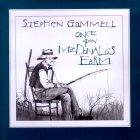
I always like to lead into something like this with something off-beat and unexpected and Stephen Gammell's Once Upon MacDonald's Farm (Macmillan, 1990 ISBN 0-689-71379-7) should give the audience a clue that this isn't going to be the same old unit. Lulled by the name of the farm's owner we think we're in for more e-i-oing, but Gammell's MacDonald is not an adept farmer. Sensing that his farm needs animals, he purchases an elephant, a baboon and a lion. The look on the baboon's face as MacDonald comes ready to gather eggs is only outdone by the look on the lion's at milking time. Even when a kindly neighbor gives him proper farm animals, MacDonald has one more laugh and surprise for us.
Song
However, backhandedly or not, Gammell has brought us to the song. Bring out as many versions as possible: I like Colin Hawkins' (Price Stern, 1991 ISBN 0-8431-2884-4,) and Glen Rounds' (Holiday, 1989 ISBN 0-8234-0739-X.) A discussion of everybody's favorite version means you're looking primarily at illustrative styles. Make a list of the various animals in all the versions and you've got the starting list for research. Sing the song of course and print it on a large chart for some whole language work, asking the kids what they notice about the words. Then take a leaf from Gammell's book and bring out some non-fiction books on some of the exotic animals living on farms these days: ostriches, llamas and exotic fowl. Sing the song again putting in some of those animals and their sounds. Children who live in rural areas and even some who don't will know that cows don't say "Moo" and horses seldom say "Neigh." How about another rendition with real animal sounds? Enough? Let's move on to more farm songs like "How Ya Goin' Keep `em Down on the Farm," "Sweetly Sings the Donkey," "When Cows Get Up in the Morning," "Oat, Peas, Beans and Barley Grow," "The Farmer in the Dell," and "Knock-Kneed Chicken," are a few from my muddled brain. What can you add? How about the kids?
Bulleting Boards
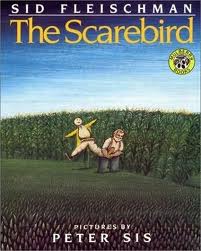
Is it time for a bulletin board? When I think of farms, I think of scarecrows and there are many of them in literature. Sid Fleischman and Peter Sis' Scarebird (Greenwillow, 1988 ISBN 0-688-07317-4) is one of my favorite books so it springs to mind first. Will you put him on the board the way he looks at the beginning and end of the book or the view from the middle where he's become a silent companion to John? Wizard of Oz's Scarecrow will be familiar to most of the children. If there are scarecrows, there have to be crows and other birds not so far off. Which ones will you choose from literature? Joan Aiken's Mortimer? Mrs. Gaddy's crows? (see below) Brock Cole's "Winter Wren"? Mary Lennox's robin? Bill Peet's Homer? Nancy Van Laan's Rainbow Crow?
Word Play
While you're on the subject of scarecrows, notice that Fleischman used "Scarebird." Since he played with the word, maybe you and the children can look for other synonyms for scare and crow and come up with new compounds like: shockrobin, terrorsparrow, frightenwren, alarmraven, dismaywarbler, and panicpigeon.
Farm Books:
Humorous
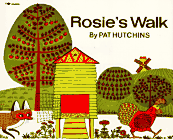
There are so many great books with settings in and around a farm that you'll have no trouble finding many choices. Can we go for mood instead of strict subject? If we make three main categories: Humorous, Descriptive and Factual, will we have it covered? Humorous books about the farm would include Beats Me, Claude (Viking, 1986 ISBN0-670-80781-8.) Those of you who read my columns regularly already know about my delight in that one. I also like Mrs. Gaddy and her love/hate relationship with a crow by Wilson Gage and all of those adventures have been brought out in one cover: My Stars , It's Mrs. Gaddy! (Greenwillow, 1991 ISBN 0-688-10514-9.) Pat Hutchins' Rosie's Walk (Macmillan, 1971 ISBN 0-02-745850-4) remains an all time slapstick favorite. Try having the kids tell or illustrate the story from the fox's point of view. And don't assume this is only a book for the youngest. Older students can analyze the book. What makes it funny? What role does anticipation have in the humor here? Are there other books in which the illustrations tell a different story from the words? William Steig's Farmer Palmer's Wagon Ride (Farrar, 1974 ISBN 0-374-32288-0) belongs with the funny farm books (no pun intended.) Can we include David Macauley's Why the Chicken Crossed the Road (Houghton, 1987 ISBN 0-395-44241-9) because it starts with a farm animal at least? Speaking of which, isn't that book really a fifth part of the author's prize winning Black and White (Houghton, 1990 ISBN 0-395-52151-3)?
Descriptive Books
Descriptive books might include Whoo-oo Is It? by Megan McDonald and S. D. Schindler (Orchard, 1992 ISBN 0-531-08574-0) which zeroes in on the sounds heard in a barn by a barn owl. Peter Parnall's Winter Barn (Macmillan, 1986 ISBN 0-02-770170-0) goes in that pile as well. So does Bonnie Pryor's Greenbrook Farm (Simon and Schuster, 1991 ISBN 0-671-69205-4.) There's no shortage of descriptive and lyrical books about the farm.
Other Farm Books
Where will we put books like Chris Van Allsburg's The Stranger (Houghton, 1986 ISBN 0-395-42331-7)? We need more categories. Maybe weird, fanciful, and sad will give us more room. Surely Jan Andrews' The Auction (Macmillan, 1991 ISBN 0-02-705535-3) belongs among the sad books although there's a note of hope at the end.
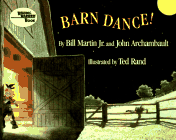
The point is that, by exploring a topic through children's books, children get many views of the same subject. Comparing fictional with non-fictional material is an obvious and useful activity. We can also compare personalities. What would a hen party composed of the Little Red Hen, Hattie from Hattie and the Fox, by Mem Fox (Bradbury, 1988 ISBN 0-02-735470-9) Rosie and the chickens from The Millionth Egg by Bernice Myers (Lothrop, 1991 ISBN 0-688-09887-8) be like? Would they like Roger Duvoisin's Petunia? Would the Cow that Fell into the Canal from Phyllis Krasilovsky's book (Doubleday, 1985 ISBN 0-385-07585-5) strike up a romance with Ferdinand? What would the Boy with questions in his head from Bill Martin Jr's Barn Dance (Holt, 1986 ISBN 0-8050-0089-5) think of Lonesome John? Would he invite him to the next hoe down?
We haven't even touched the non-fiction. We haven't talked in many languages about the various animals and objects on the farm. We haven't designed a farm of the future. There's a whole pile of novels with farm settings. So many farms. So little time.
More Related Books
 Hello, Day! by Anita Lobel. (Greenwillow, 2008 ISBN 9780060787660. Order Info.) Picture Book. Grades PreK-K.
Hello, Day! by Anita Lobel. (Greenwillow, 2008 ISBN 9780060787660. Order Info.) Picture Book. Grades PreK-K.
This is a good example of how a common concept, farm animals and the noises they make, can be rendered by a master using a simple style and yet result in something that transcends its simplicity. Rich paintings which both inspire and soothe accompany predictable text: 'The Cat said, 'Meow.'" A perfect match for the preschool set or a young beginning reader.
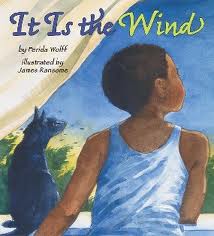 It Is the Wind by Ferida Wolff. Illustrated by James Ransome. (2005, HarperCollins. ISBN 9780060281922. Order Info.) Picture Book. 32 pages. Gr PreK-2.
It Is the Wind by Ferida Wolff. Illustrated by James Ransome. (2005, HarperCollins. ISBN 9780060281922. Order Info.) Picture Book. 32 pages. Gr PreK-2.
Lyrical text with rhyming onomotopoeia describe the thoughts of an African American boy awakened during the night by the sounds of the country. The text is accompanied by beautiful watercolor illustrations. Read More.
 The Life of Rice: From Seedling to Supper by Richard Sobol. (2010, Candlewick. ISBN 9780763632526. Order Info.) Nonfiction Photographic Essay. 40 pages. Gr 2-6.
The Life of Rice: From Seedling to Supper by Richard Sobol. (2010, Candlewick. ISBN 9780763632526. Order Info.) Nonfiction Photographic Essay. 40 pages. Gr 2-6.
In Thailand life centers around the growing and harvesting of rice. Here, with beautiful photographs, Sobol gives us a tour of the harvest celebrations and the families and farms that tend this essential crop. This is an excellent entry in the Traveling Photographer series.
 Alida's Song by Gary Paulsen. (2001, Yearling. ISBN 978-0440414742 . Order Info.) Short Novel. 96 pages. Gr 4-8.
Alida's Song by Gary Paulsen. (2001, Yearling. ISBN 978-0440414742 . Order Info.) Short Novel. 96 pages. Gr 4-8.
The grandmother who dominated Cook Camp is back in this brief and very accessible novelette. With his alcoholic parents alternating between neglect and abuse, the young man is set for a summer of wary survival until the invitation comes from his grandmother to spend the summer with her.
Related Areas of Carol Hurst's Children's Literature Site
- Barn Dance! Book review.
- Work and Occupations in Children's Books.
- Miss Bridie Chose a Shovel. Featured Book with activities, related books and links.
Advertisement:
Advertisement:
Advertisement:

